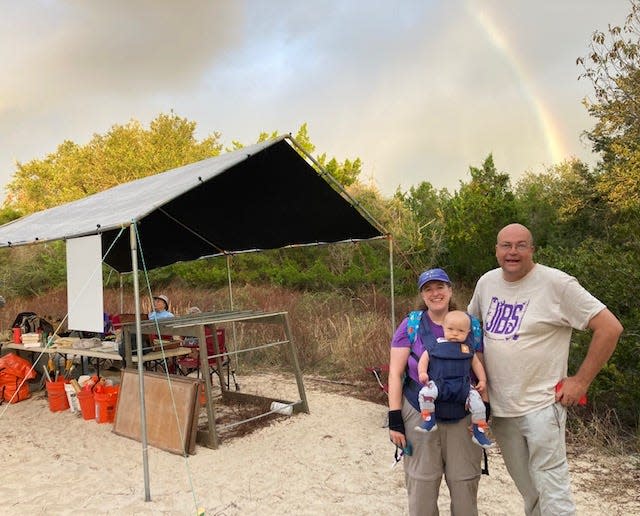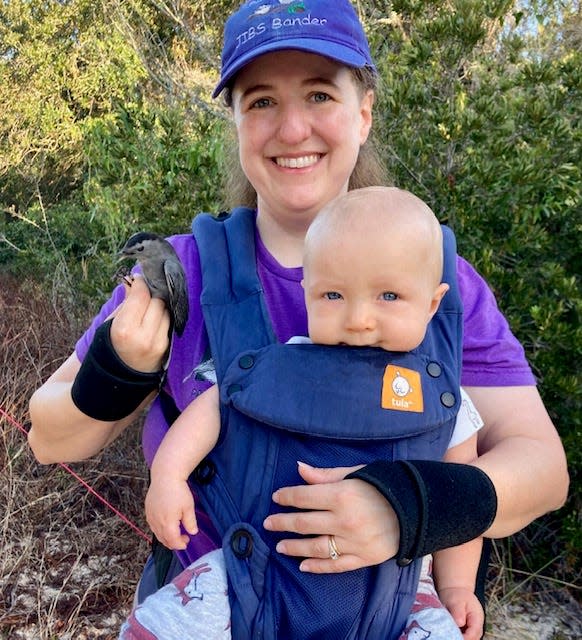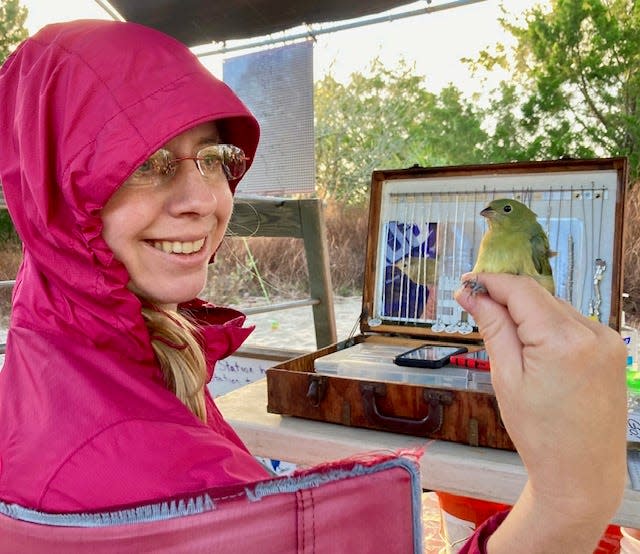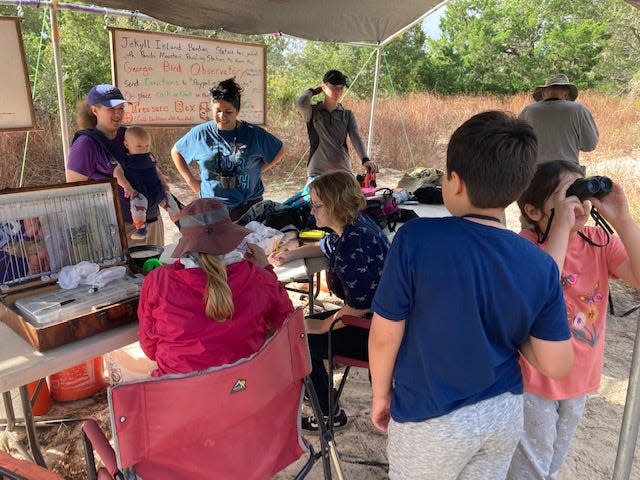Banding Georgia's migratory birds provides valuable biological, ecological information
For many, October brings bright foliage, cooler temps and the return of pumpkin spice lattes. But for bird lovers, October begins fall migration when species leave North America and head south for the winter.
In the soft luster of pre-dawn, a team of biologists and citizen scientists set up a series of nets on the south end of Jekyll Island. All 17 are a little like extra-large volleyball nets but designed to safely ensnare birds in a range of sizes. They are placed in the same locations each year, and since 1978, volunteers have caught, evaluated, banded and released upwards of 1,000 birds from them every October.
A few days before Halloween, data collectors at the Jekyll Island Banding Station (JIBS) observe a steady, yet predictable, decline of birds in the nets, signaling the end of migration. Most birds are now well on their way to Central and South America.

Heather Pitman, a biologist and environmental scientist from Norcross, Georgia, is among primary volunteer staff at JIBS, and since 2011, Pitman and her husband Evan have been coordinating and leading data collection efforts at the station.
Pitman began banding birds in 2007 at Panola Mountain in Stockbridge, Georgia, where she got hands-on training extracting them from nets. Then, she focused on learning specific nuances of each species to determine sex, age and body fat index. Beak and eye color plus feather growth patterns are a few physiological aspects that banders consider when determining important pieces of biological data for each bird.
Over the years, the Pitmans have observed distinct patterns and changes at JIBS. Typically, the station records a high number of hatch-year birds, and Heather Pitman has an idea as to why that is.
“Statistically, there are just more hatch-years,” said Pitman. “Most don’t survive past their first year. Plus, in terms of migration, adult birds tend to migrate sooner. They leave earlier, possibly before we are set up at the station, and the hatch-years are left behind to figure it out. It could be that since it’s their first time, the hatch-years are more likely to follow the coastline during migration. Because they’ve never done it, hatch-years may not want to stray so far over the ocean and end up in our nets.”

Pitman also noted that the 2023 banding season marked the most birds ever recorded at JIBS—1,750 individuals representing 57 different species. And she has a few ideas as to why this may be the case, as well.
“Perhaps it means the habitat is more useful to the birds,” considered Pitman. “This area is now closed to the public during the rest of the year, so having undisturbed habitat means there’s more cover and vegetation, like native partridge pea, and that attracts more bugs and birds. If there are more migrating birds attracted to this habitat, then that increases the chances of them getting caught and recorded in our nets.”
Winds, warehouse development may affect migratory bird habitat, pathways
But there could be another possibility why so many more birds are drawn to the Jekyll Island habitat this season.
In recent years, tens of thousands of forested land and uncultivated habitat have been cleared for warehouse construction and port development in Coastal Georgia. Much of those cleared acres is not only prime migratory bird breeding habitat, but also important stop over and refueling points along the East Coast flyway. That so many more birds were banded and recorded in the nets at Jekyll Island could be due, in part, to loss of important habitat within migration routes.
Dr. Nick Bayly, an ornithologist and research scientist with Colombia-based conservation organization, SELVA, is cautious when it comes to deciphering changes at banding stations. Bayly indicates that weather patterns often play a significant role in how bird migration shifts from one season to the next. Bayly also directs a banding station in a remote desert community in northeastern Colombia.
“At our Guajira station we had just 450 migrants this year, while in previous years that total has been 1,600,” emphasized Bayly. “Normally winds circulate around the Gulf from southwest to northeast and push birds more towards Florida and the Atlantic coast. This year, however, there were extended periods of north-easterly and easterly winds over the Gulf, blowing birds from the Atlantic coast further west than they might normally have migrated.”

While wind patterns may account for decreased birds at Colombia’s Guajira station, wind patterns don’t fully explain why JIBS banded a record 13 yellow-billed cuckoos, a species that typically doesn’t fly over the Atlantic Ocean during migration and therefore would not have been pushed westward over land.
According to Pitman, in years past, JIBS has captured two to three, and in some years, zero yellow-billed cuckoos, which is why significant, recent habitat loss across the Southeast could partially explain the increase of birds, in particular yellow-billed cuckoos, banded at Jekyll Island this year.
Bayly went on to emphasize that sustained, long-term data collection is key in understanding the health and status of bird species, especially that of the elusive and not well-studied in North America, yellow-billed cuckoo, now in steep decline across all of its North American breeding range.
“The value of these stations is heightened when we combine data across multiple stations, which smooths out some of the interannual variation. Under such a scenario, we can get at interesting questions such as how productivity varies from year to year. This is especially important for high boreal breeding species that are poorly monitored by existing North American surveys.”

Volunteerism the whole family can do together
The Jekyll Island banding station isn’t just for biologists and research scientists. In fact, the station is open to volunteers and observers wanting to learn more about birds, which is exactly how Jacksonville resident Monica Ratliff and her two children got involved.
“I put up a birdfeeder in May, and the kids began watching and asking questions,” explained Ratliff. “So, we started with a Florida bird book and binoculars, and then we started learning and identifying birds.”
Ratliff, who homeschools her daughter, Myra, age 7, and son, Ryan, age 10, went to work locating as many resources as she could to support their burgeoning interest. She found books at the library and sought out local places to birdwatch. The family even built a bluebird nest box from which four young birds fledged this summer.
But when she stumbled across JIBS online, Ratliff knew she found something special to boost her children’s learning. The station was only an hour and twenty minutes from their home and seemed like an excellent learning opportunity for all of them. The trio visited the station every day in its last week of operation this October.
“Everyone was so amazing with the kids, especially Evan,” said Ratliff. “He shared so much information about how to further identify birds by their feathers and how to tell the hatch-year birds of different species. Both kids got to hold different ones and set the birds free. It just warms our heart that everyone does this as a volunteer. I told my home-schooling group all about JIBS, and we will definitely be back next year.”
To get involved and learn more about some of the species banded this October at the Jekyll Island Banding Station, georgiabirdobservatory.org/our-projects.
This article originally appeared on Savannah Morning News: volunteer to band migrating birds on Georgia's Jekyll Island

